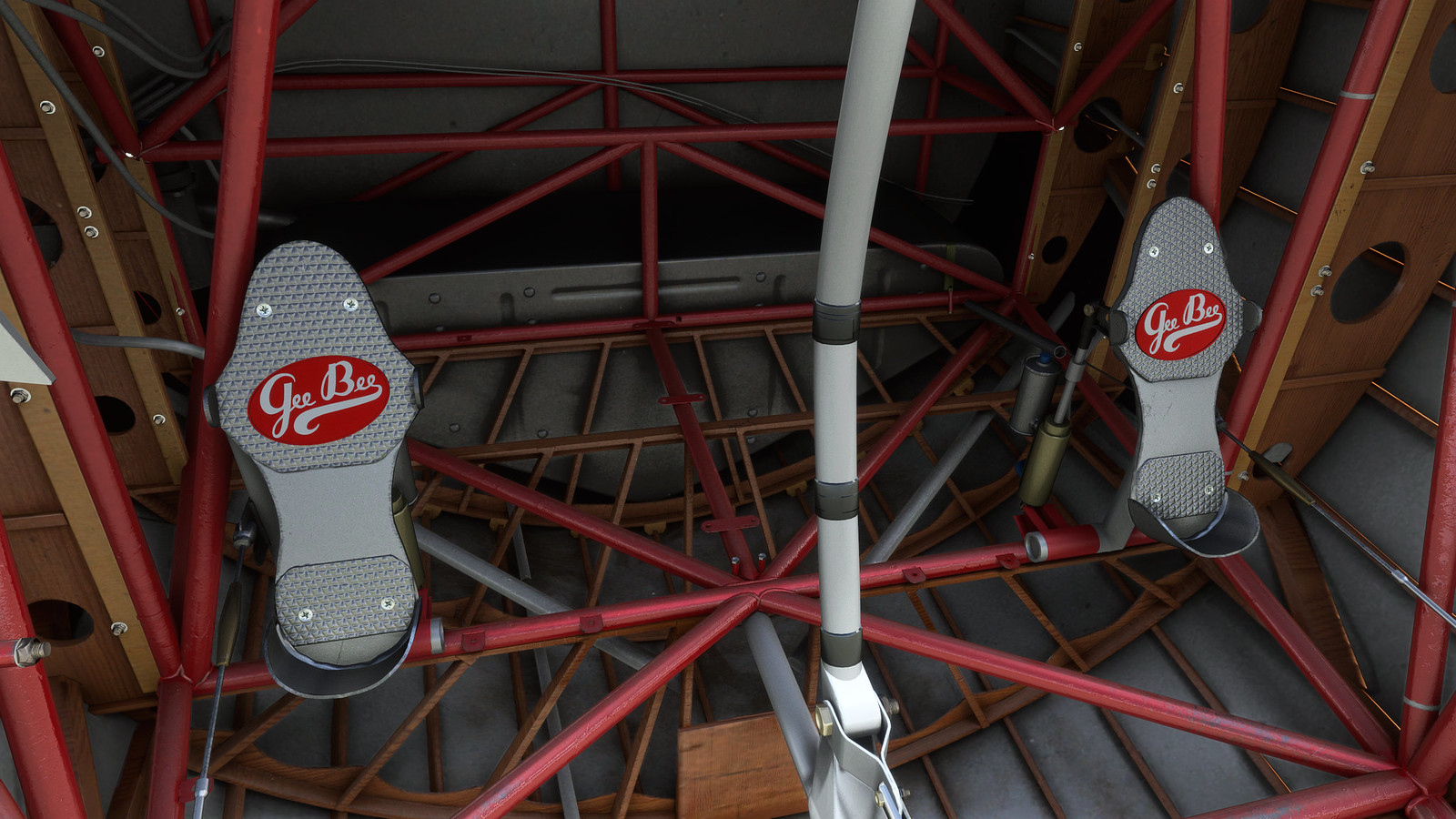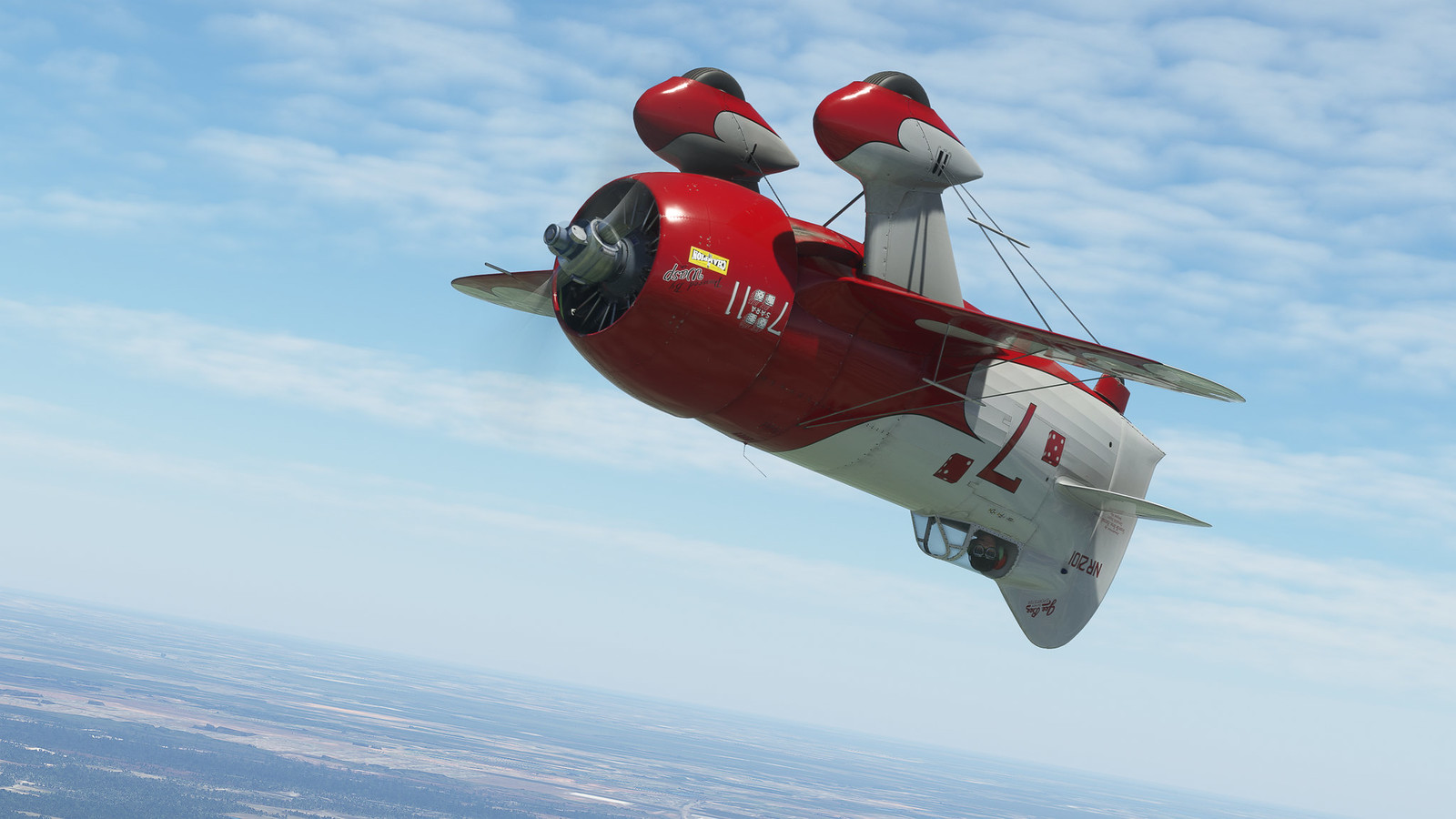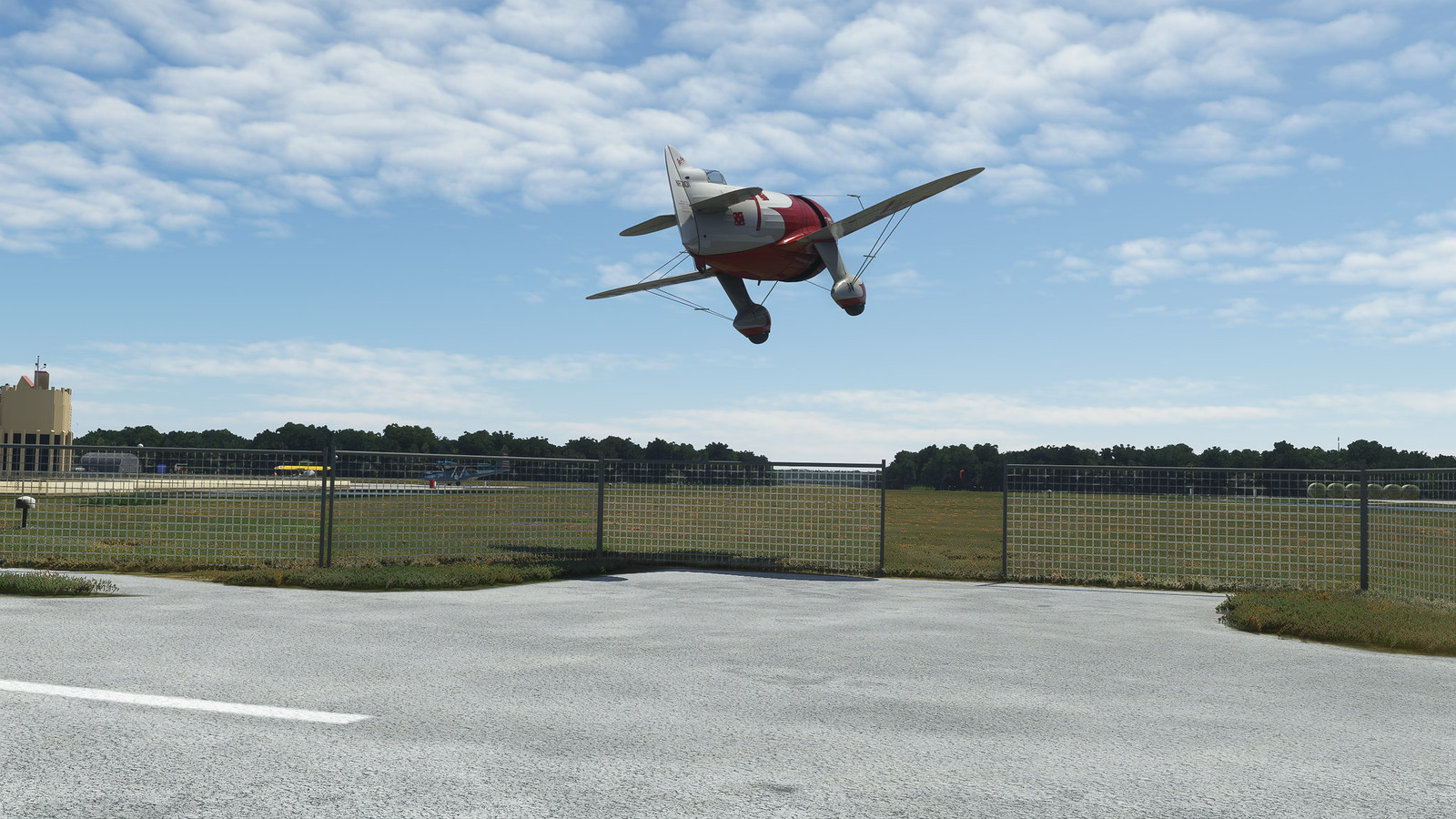Bomber_12th
SOH-CM-2025
Because of my interest in the type, I thought I would start a new thread just focused on these two recently-released aircraft. They are available through the MSFS Marketplace at a cost of about $15 USD, together as a single product.
I blame my dad for my affection for the Gee Bee R-1 and R-2, as they were his favorite aircraft and I simply couldn't avoid it. I was fortunate enough to see Delmar Benjamin's replica R-2 at an airshow once in the 90's, and we of course had models, books and artwork of the R-1/R-2 around the house when I was growing up. I have just always thought it was such a neat looking aircraft, and they represented what state-of-the-art aviation was for their time. I've bought every FS addon Gee Bee R-type going back to the days of FS2002, and as far as accurately depicting the flight dynamics of the Gee Bee R-1/R-2 in FS, it always has seemed to be a great challenge for developers, as no one has ever gotten it quite right. Having been flying the newly-released Carenado R-2 for the past five days, I've gotten a handle on it with consistent takeoffs/landings, to the numbers, that I'm quite proud of, and thought I would write out my experiences with the aircraft to-date as well as add information here about how the real thing is said to fly/handle.
The original Gee Bee R-1 and R-2 were built in 1932 by the Granville Brothers Aircraft company, located in Springfield, Massachusetts, as successors to their Gee Bee Model Z which had won the Thompson Trophy race in 1931. Where as the R-1, with its larger engine, was designed to compete in the 1932 Thompson Trophy Race (which it won), and would set the landplane speed record, the R-2, with its smaller engine but sleeker cowling and much larger fuel capacity, was designed to compete in the long-distance cross-country Bendix Race.
The Carenado Gee Bee R-2 happens to be modeled, obviously using laser scans, directly from the replica built by Delmar Benjamin and Steve Wolf, which first flew on December 23, 1991. Aerodynamically-exact to the original, the only compromises to the replica were that hydraulic brakes were installed, the tailwheel was made steerable, and an inverted oil system was installed so that Delmar, an accomplished aerobatic pilot, could fly the aircraft inverted for a prolonged period. When Delmar retired himself from flying his R-2 in 2002, he had put well over 700 hours of flight time on the aircraft, having flown it in displays at airshows all around the US, as well as in France and Germany. In 2004 it was acquired by Kermit Weeks and it has been displayed ever since at his Fantasy of Flight attraction in Florida.
The engine installed in both the original R-2 and Delmar Benjamin R-2 is the Pratt & Whitney R-985 "Wasp Jr." The racing R-985 installed on the original R-2 is said to have been rated at 535 Hp, where as the one fitted to Delmar Benjamin's was about 510 Hp.
The visual model and sounds for the Carenado R-2 are absolutely stunning. It is incredible the amount of detailing that is present throughout the cockpit, even in areas that normally you wouldn't easily be able to see. Save for a minor issue with the dice markings on the left side of the fuselage (surely to be corrected in a future update), the visual model is jaw-dropping to behold. I also find the sounds to be of a very high quality and very accurate.
Flying the aircraft in the sim, I first started out at Reno Stead, with its large runways. I did perhaps as many as six test flights there to see what the handling/airspeeds were like. From there I then took it to Kermit Weeks' place (Fantasy of Flight), where I have since been doing all of my Gee Bee flying. Each flight I've been doing, I've been only using 50-gal of fuel, which is plenty for my 15-20 min flights.
One of the attributes about the Gee Bee R-2 is that, when the aircraft is in a three-point attitude on the ground, the rudder has next to no authority, with the rest of the airframe blocking most of the propwash. In the three-point attitude, the pilot also has extremely limited forward visibility. As a result of these issues, Delmar Benjamin would advance the throttle to takeoff power very early and get the tail up in the air as soon as he could on the takeoff roll. I've been doing the same process with the Carenado model, and it works very well! There's actually less tendency for the aircraft to swing to either side on takeoff as well.
Delmar mentioned after the first test flight that the R-2 stalls at around 100 mph (and more specifically stated years later that it stalls at 95 mph). Testing the Carenado model in the sim, the aircraft stalls just at around those same numbers, 95-100 mph. On takeoff, I've been waiting till the aircraft reaches 120-125 mph before letting the aircraft fly off the runway (which I believe may be correct, or a bit too slow - Delmar would say that the faster you are with the R-2, the better).
When it came to landing, Delmar would fly the R-2 at 140-145 mph on final, and touchdown at 120 mph. When doing so, he would be side-slipping over the threshold as he was nearing the runway, as the nose would be too high to see over at those speeds. Then, just over the threshold, he would straighten out with the runway, at around which time the tail would start to lower still (increased angle of attack at that lower speed), at which point only the sides of the runway could be seen. Once the tires contacted with the runway, he would push the stick forward to raise the tail up and keep it up down the whole distance of the landing roll, so as to be able to both maintain rudder control and be able to have better visibility straight ahead. He would always then soon be on the brakes, with the tail up, until it was slowed down to taxi speed, before he would gently lower the tail to the runway. Delmar described landing the R-2 like "riding a cannonball".
Flown just as Delmar described, I've been landing the Carenado R-2, consistently, in the exact same manner, and it seems to behave/handle very closely in this regard as well.
Where I find the flight dynamics of the Carenado R-2 to be not up to snuff is in the flight control characteristics/overall feel of the aircraft (but which is true of every R-1/R-2 I've ever flown in FS). Delmar described the control surfaces of the R-2 as incredibly sensitive. So much so, he said the R-2 was four-times more sensitive in pitch/roll/yaw as a Pitts Special, as well as being divergent and twitchy (all characteristics that Delmar loved about it). Delmar described it as being "happy" in feel, with the feeling of the ailerons making him just want to roll it (which he did on the very first test flight). Jimmy Doolittle described the handling characteristics of the R-1 as being like balancing a pencil on the tip of your finger. The flight model of the Carenado R-2 is simply just far too stable. It is however still quite maneuverable, and I have been enjoying doing rolls and Cuban 8s. It will also be really great if when the MSFS flight model is improved enough so as to allow knife-edge flying, since the real R-2 (and Model Z), flying at 200 mph or more, can hold knife edge flight indefinitely.
These are the Pratt & Whitney R-985 "Wasp Jr." typical power settings - take-off: 36.5-in MP / 2300 RPM - climb: 30.5/29-in MP / 2100/2000 RPM - standard cruise: 26.5/24-in MP / 2000/1950/1800 RPM. I have been using just 30-in MP on takeoff, and bringing the prop back to 2000 RPM on the climb. For cruise I've been using 24-in MP/1800 RPM.
So that is mostly my take on the Carenado R-2 thus-far! I have taken up the Model Z a few times as well, but I will have to fly it some more before I add a post to this thread about that one.
Here is a little bit of a detailed look at the virtual R-2, inside and out.






I blame my dad for my affection for the Gee Bee R-1 and R-2, as they were his favorite aircraft and I simply couldn't avoid it. I was fortunate enough to see Delmar Benjamin's replica R-2 at an airshow once in the 90's, and we of course had models, books and artwork of the R-1/R-2 around the house when I was growing up. I have just always thought it was such a neat looking aircraft, and they represented what state-of-the-art aviation was for their time. I've bought every FS addon Gee Bee R-type going back to the days of FS2002, and as far as accurately depicting the flight dynamics of the Gee Bee R-1/R-2 in FS, it always has seemed to be a great challenge for developers, as no one has ever gotten it quite right. Having been flying the newly-released Carenado R-2 for the past five days, I've gotten a handle on it with consistent takeoffs/landings, to the numbers, that I'm quite proud of, and thought I would write out my experiences with the aircraft to-date as well as add information here about how the real thing is said to fly/handle.
The original Gee Bee R-1 and R-2 were built in 1932 by the Granville Brothers Aircraft company, located in Springfield, Massachusetts, as successors to their Gee Bee Model Z which had won the Thompson Trophy race in 1931. Where as the R-1, with its larger engine, was designed to compete in the 1932 Thompson Trophy Race (which it won), and would set the landplane speed record, the R-2, with its smaller engine but sleeker cowling and much larger fuel capacity, was designed to compete in the long-distance cross-country Bendix Race.
The Carenado Gee Bee R-2 happens to be modeled, obviously using laser scans, directly from the replica built by Delmar Benjamin and Steve Wolf, which first flew on December 23, 1991. Aerodynamically-exact to the original, the only compromises to the replica were that hydraulic brakes were installed, the tailwheel was made steerable, and an inverted oil system was installed so that Delmar, an accomplished aerobatic pilot, could fly the aircraft inverted for a prolonged period. When Delmar retired himself from flying his R-2 in 2002, he had put well over 700 hours of flight time on the aircraft, having flown it in displays at airshows all around the US, as well as in France and Germany. In 2004 it was acquired by Kermit Weeks and it has been displayed ever since at his Fantasy of Flight attraction in Florida.
The engine installed in both the original R-2 and Delmar Benjamin R-2 is the Pratt & Whitney R-985 "Wasp Jr." The racing R-985 installed on the original R-2 is said to have been rated at 535 Hp, where as the one fitted to Delmar Benjamin's was about 510 Hp.
The visual model and sounds for the Carenado R-2 are absolutely stunning. It is incredible the amount of detailing that is present throughout the cockpit, even in areas that normally you wouldn't easily be able to see. Save for a minor issue with the dice markings on the left side of the fuselage (surely to be corrected in a future update), the visual model is jaw-dropping to behold. I also find the sounds to be of a very high quality and very accurate.
Flying the aircraft in the sim, I first started out at Reno Stead, with its large runways. I did perhaps as many as six test flights there to see what the handling/airspeeds were like. From there I then took it to Kermit Weeks' place (Fantasy of Flight), where I have since been doing all of my Gee Bee flying. Each flight I've been doing, I've been only using 50-gal of fuel, which is plenty for my 15-20 min flights.
One of the attributes about the Gee Bee R-2 is that, when the aircraft is in a three-point attitude on the ground, the rudder has next to no authority, with the rest of the airframe blocking most of the propwash. In the three-point attitude, the pilot also has extremely limited forward visibility. As a result of these issues, Delmar Benjamin would advance the throttle to takeoff power very early and get the tail up in the air as soon as he could on the takeoff roll. I've been doing the same process with the Carenado model, and it works very well! There's actually less tendency for the aircraft to swing to either side on takeoff as well.
Delmar mentioned after the first test flight that the R-2 stalls at around 100 mph (and more specifically stated years later that it stalls at 95 mph). Testing the Carenado model in the sim, the aircraft stalls just at around those same numbers, 95-100 mph. On takeoff, I've been waiting till the aircraft reaches 120-125 mph before letting the aircraft fly off the runway (which I believe may be correct, or a bit too slow - Delmar would say that the faster you are with the R-2, the better).
When it came to landing, Delmar would fly the R-2 at 140-145 mph on final, and touchdown at 120 mph. When doing so, he would be side-slipping over the threshold as he was nearing the runway, as the nose would be too high to see over at those speeds. Then, just over the threshold, he would straighten out with the runway, at around which time the tail would start to lower still (increased angle of attack at that lower speed), at which point only the sides of the runway could be seen. Once the tires contacted with the runway, he would push the stick forward to raise the tail up and keep it up down the whole distance of the landing roll, so as to be able to both maintain rudder control and be able to have better visibility straight ahead. He would always then soon be on the brakes, with the tail up, until it was slowed down to taxi speed, before he would gently lower the tail to the runway. Delmar described landing the R-2 like "riding a cannonball".
Flown just as Delmar described, I've been landing the Carenado R-2, consistently, in the exact same manner, and it seems to behave/handle very closely in this regard as well.
Where I find the flight dynamics of the Carenado R-2 to be not up to snuff is in the flight control characteristics/overall feel of the aircraft (but which is true of every R-1/R-2 I've ever flown in FS). Delmar described the control surfaces of the R-2 as incredibly sensitive. So much so, he said the R-2 was four-times more sensitive in pitch/roll/yaw as a Pitts Special, as well as being divergent and twitchy (all characteristics that Delmar loved about it). Delmar described it as being "happy" in feel, with the feeling of the ailerons making him just want to roll it (which he did on the very first test flight). Jimmy Doolittle described the handling characteristics of the R-1 as being like balancing a pencil on the tip of your finger. The flight model of the Carenado R-2 is simply just far too stable. It is however still quite maneuverable, and I have been enjoying doing rolls and Cuban 8s. It will also be really great if when the MSFS flight model is improved enough so as to allow knife-edge flying, since the real R-2 (and Model Z), flying at 200 mph or more, can hold knife edge flight indefinitely.
These are the Pratt & Whitney R-985 "Wasp Jr." typical power settings - take-off: 36.5-in MP / 2300 RPM - climb: 30.5/29-in MP / 2100/2000 RPM - standard cruise: 26.5/24-in MP / 2000/1950/1800 RPM. I have been using just 30-in MP on takeoff, and bringing the prop back to 2000 RPM on the climb. For cruise I've been using 24-in MP/1800 RPM.
So that is mostly my take on the Carenado R-2 thus-far! I have taken up the Model Z a few times as well, but I will have to fly it some more before I add a post to this thread about that one.
Here is a little bit of a detailed look at the virtual R-2, inside and out.






Last edited:






















